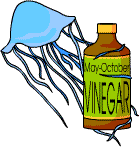The Cnidaria
Created | Updated Apr 7, 2006
You might be forgiven for thinking that sea pens, anemones and corals are all types of plant but in fact they are an ancient branch of the animal kingdom known as Cnidaria. The Cnidaria* are a Phylum which also contain jellyfish as well as the aforementioned creatures. There are roughly 9000 species of Cnidaria although estimates vary.
Cnidaria evolved a long time ago, the oldest known fossils of Cnidaria date from around 680 million years ago. Before then little is known of their evolutionary history. This is because the chance of finding fossils in older rocks is slim as they are much more likely to have been destroyed by geological processes such as erosion. Also, Cnidaria do not have hard parts, like bones, which are easily preserved in rocks.*
Physiology
The Cnidarians are unique in that they possess stinging tentacles known as nematocysts or cnidae (though some species may have lost or adapted the basic design) which surround their mouth. The nematocysts are used to capture and stun prey. If you've come across anemones or jellyfish at the beach you may be aware of their effectiveness in this task. Nematocysts are a vital adaptation because most Cnidaria are carnivores though some, like corals, may have formed symbiotic relationships with organisms such as zooxanthellae which allow them to gain energy through photosynthesis.
The body plan of the Cnidarians is relatively simple. Their bodies are radially symmetrical and 'cup' like, having one open end which serves as both mouth and anus.
Cnidarians exhibit two adult shapes; polyps and medusae. Jelly fish exhibit a typical medusoid shape. They generally hang in the water with their mouths pointed downwards and tentacles swaying. Polyps attach themselves to rocks with the end opposite to their mouths and are generally sessile.* Examples of polyps include anemones, corals and sea pens.
Cnidarians have a simple muscle and neural network which allows them to respond to their environment, and in the case of medusae to move around. Cnidarians gain their jelly-like status from the internal fluid which connects the outer body layer, the ectoderm, to the inner body layer, the endoderm. This internal jelly-like structure is known as the mesogloea.

Phylogenetics
The Cnidaria are split into four smaller groups known as classes; Anthozoa,1
Scyphozoa,*
Hydrozoa*
and Cubozoa.*
There is hot debate as to which class is the oldest and thus which class the other three evolved from. However most people believe that this honour should go to the Anthozoa. This would mean that the polyp like body form would be the most primitive.
Ctenophores, or comb jellies, superficially resemble jelly fish, they are wibbly and have long trailing tentacles. In the past Ctenophora and Cnidaria were considered closely related because they have similar body plans. However, the resemblance between Cnidaria and Ctenophores is likely to be due to convergant evolution.
Convergant evolution occurs when two evolutionary distant or physically distant species or populations evolve the same behaviour or physically adapt to their environment in the same way. From two different origins species can converge to appear similar or identical to each other even though they may be unrelated.
In a way, the ability to fly is a case of convergant evolution. Although the mechanisms are different in birds, bats, insects and the flying dinosaurs they all, independantly, gained the ability to fly. So Cnidaria and Ctenophores may appear to be closely related because they look so similar but their similarities may be caused by convergant evolution.
Conservation
The Cnidaria form a diverse and important group of species. Coral reefs are obviously important for many species and are often referred to as the 'rainforests' of the sea. However, due to coral's symbiotic relationship with photosynthetic organisms which give them their energy they are particularly susceptible to problems like coral bleaching and pollution.
Coral bleaching occurs when the symbiotic zooxanthellae leave their coral hosts due to adverse conditions. It can occur for many reasons such as a change in sea temperature, increased pollution or reduced light levels. If the temperature changes by sometimes as little as a few degrees or if there are too many pollutants in the water it can kill them off. If their departure is extended for more than a month or so the coral will start to bleach and eventually die off. Coral bleaching is unfortunately on the up and poses a serious threat to the biodiversity of the seas.
Another important conservation issue is one that involves jellyfish indirectly. Many sea turtles live on a diet of jellyfish and innocently eat the plastic bags and other detritus that we throw away believing them to be delicious snacks. Unfortunately the plastic bags get stuck in their digestive systems. The lucky turtles receive help from conservationists who remove the indigestible bags. The unlucky ones often die as their digestive systems become clogged.
There is a wealth of information about this ancient phylum but, as with all species that live in the sea, there still remains much to be learnt about their way of life and their ecology.
